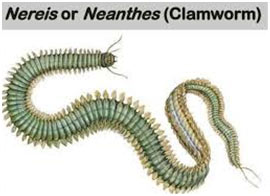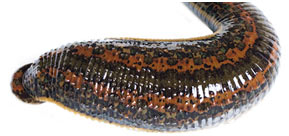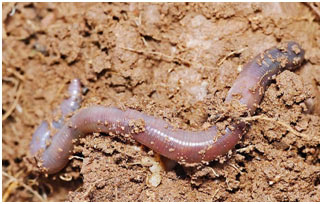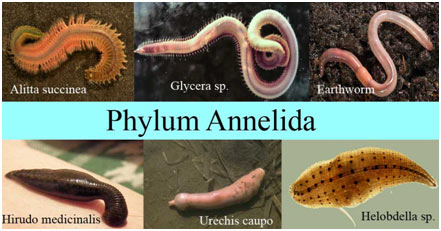The word Annelida is derived from Latin which means “little ring“.
The majority of the worms which we recognize are considered in this phylum. They are segmented and commonly called annelids.
- 1) General Characteristics of Phylum Annelida
- 2) Movements in Phylum Annelida
- 3) Reproduction in Phylum Annelida
- 4) Phylum Annelida comprises:
- 5) Class Polychaeta
- 6) Class Oligochaeta
- 7) Class Hirudinea
- 8) Economic Importance
- 9) Answers to Common Questions – Phylum Annelida
- 10) Summarzing Phylum Annelida
- 11) You may also like to learn:
General Characteristics of Phylum Annelida
Grade of organization
The animals are triploblastic and coelomate.
Shape and Symmetry
The body is metamerically segmented. These animals reveal bilateral symmetry.
Habitat:
The annelids consist of worms, which may be marine (Nereis), freshwater (stylaria), or found in moist or damp soil (earthworms). Some are parasites, for example, Hirudo (leech).
Body Cavity
The body ends up being divided transversely into a variety of similar parts or sections called segments. The subdivisions might be indicated externally by constriction of the body surface. Internally, the segments are separated from each other by septa extending across the coelom.
Annelids have true coelom i.e. the mesoderm splits into the parietal layer which lines the body wall, and the visceral layer which covers the alimentary canal, the area in between the two layers of mesoderm, is the coelom and is filled in by coelomic fluid, which serves- as hydrostatic skeleton likewise.
Digestive system
The gastrointestinal system remains in the kind of alimentary canal which is divided into distinct parts, each carrying out a specific function. It has two openings, the mouth at the anterior end, and the anus at the posterior end. The mouth is overhung by a lobed structure, the prostomium. In parasitic types, the digestion system is improperly developed.

Organs and Organ systems
The annelids show specialization of body structures. The organ systems are well established.
Various systems of the body such as the gut, blood vessels, and nerve cord are constant throughout the length of the body penetrating each individual segment.
Excretory System
Excretion happens by specialized structures called nephridia. These are ciliated organs present in each segment in the body cavity.
Nervous system
A well established central nervous system exists in annelids. It comprises of an easy brain and a solid double, longitudinal, ventral nerve cord. Nerves emerge in each section from the nerve cord.
Circulatory System
Annelids are the first group of invertebrates which have developed a closed circulatory system – a system in which a circulatory fluid called blood flows in a network of vessels referred to as blood vessels. It carries gases and nutrients.
Respiratory system
The breathing system is not present. The exchange of gases is by diffusion through the skin into blood capillaries. The skin is kept moist by, mucus, and coelomic fluid.
Body Wall
The body wall contains muscles which help in mobility. The muscles are of 2 types:
- Circular Muscles: These are arranged along the circumference of the body.
- Longitudinal Muscles: These are organized along the length of the body.
Movements in Phylum Annelida
The mobility is brought about by the interaction of muscles and the hydrostatic skeleton. The contraction of circular muscle produces pressure in the coelomic fluid that requires the body to lengthen. Likewise, the contraction of longitudinal muscles produces pressure in the coelomic fluid that would trigger the body to widen.
The organs of locomotion in annelids are chitinous chaetae or setae embedded in sacs (earthworm) or on parapodia present in the body wall (e.g., Nereis). Chaetae are absent in leech.
Reproduction in Phylum Annelida
Sexual reproduction
The common mode of reproduction is sexual. The majority of annelids (Earthworm, leech) are hermaphrodite (having both male and female). In some annelids (e.g., Nereis) the sexes are different, the fertilization is external.
Life cycle
A free-swimming trochophore larva is produced during the life cycle.
image
Phylum Annelida comprises:
- Class Polychaeta
- Class Oligochaeta
- Class Hirudinea
Class Polychaeta
These have a unique head region with eyes and structure known as palps and tentacles. Sexes are normally separate. The organs of locomotion are parapodia. They are mainly marine (marine). During advancement, these give rise to a trochophore larva.
Common examples are Nereis, Chaetopterus.

Class Oligochaeta
These animals have internal and external division. Organs of locomotion are setae. Head region not prominent or distinct. They are hermaphrodite (bisexual). No larva formed throughout development in Pheretima Posthuma and other earthworms. They might be terrestrial or aquatic.
e.g. Lumbricus terrestris

Class Hirudinea
They have a body with a fixed variety of segments. Each segment has extra circular rings or markings called annuli. They do not have organs of locomotion and relocation due to the contraction of their body and with the help of suckers. Mainly hermaphrodite and trochophore larva are formed during development.
They are aquatic. No unique head exists but leeches have chitinous jaws for making a hole in the skin of the host. They also have an anticoagulant secretion which is entered the wound to permit the smooth flow of blood into its digestion system where it can be saved for a very long time.
e.g. Hirudo medicinalis (medicinal leech).

Economic Importance
Burrowing activity of earthworms permits greater penetration of air into the soil and improves the drain capacity of the soil.
It also makes it possible for roots to grow downwards through the soil more quickly. Blending and churning of the soil are caused when earth which contains inorganic particles is brought up to the surface from lower areas. The earthworm is possibly the most active segmented worm in churning the soil, therefore it is frequently called as a natural plough.

Answers to Common Questions – Phylum Annelida
1. What is the grade of organization in animals belonging to Phylum Annelida?
- Animals in Phylum Annelida are triploblastic and coelomate.
2. What is the shape and symmetry exhibited by annelids?
- Annelids display bilateral symmetry, and their bodies are metamerically segmented.
3. Where do annelids primarily inhabit?
- Annelids can be found in various habitats, including marine (e.g., Nereis), freshwater (e.g., stylaria), moist soil, and some are parasitic (e.g., leech).
4. Describe the body cavity of annelids.
- The body is divided into segments, both externally and internally, with true coelom filled with coelomic fluid, acting as a hydrostatic skeleton.
5. What is the structure of the digestive system in annelids?
- Annelids have an alimentary canal with two openings, a mouth at the anterior end, and an anus at the posterior end. The prostomium overhangs the mouth.
6. How do annelids excrete waste?
- Excretion occurs through specialized structures called nephridia, which are ciliated organs present in each body segment.
7. Explain the nervous system in annelids.
- Annelids possess a well-developed central nervous system, consisting of a simple brain and a solid double, longitudinal, ventral nerve cord.
8. What type of circulatory system is found in annelids?
- Annelids have a closed circulatory system, where blood flows in a network of vessels (blood vessels), carrying gases and nutrients.
9. How do annelids respire?
- Annelids lack a respiratory system; gas exchange occurs through diffusion through the skin into blood capillaries, which are kept moist by mucus and coelomic fluid.
10. What is the significance of chaetae in annelids? – Chaetae or setae, embedded in sacs or on parapodia, serve as organs of locomotion in annelids, facilitating mobility.
11. How do annelids reproduce, and what is their life cycle? – Annelids typically undergo sexual reproduction. Most are hermaphrodites, while some have separate sexes. The life cycle often includes a free-swimming trochophore larva.
12. Name the three main classes within Phylum Annelida and provide examples for each. – The three classes are Polychaeta (e.g., Nereis), Oligochaeta (e.g., Lumbricus terrestris), and Hirudinea (e.g., Hirudo medicinalis – medicinal leech).
13. What economic importance do earthworms (Oligochaeta) have? – Earthworms play a crucial role in improving soil aeration, drainage, and nutrient availability through their burrowing and soil-churning activities. They are often referred to as natural ploughs.
Summarzing Phylum Annelida
In conclusion, Phylum Annelida encompasses organisms with a triploblastic and coelomate grade of organization. These metamerically segmented animals exhibit bilateral symmetry and thrive in diverse habitats, including marine, freshwater, and moist soil. The body cavity, divided into segments, features a true coelom filled with coelomic fluid, serving as a hydrostatic skeleton.
Annelids possess a well-developed digestive system with a lobed prostomium, and their organ systems, including the excretory, nervous, and circulatory systems, demonstrate specialization. The absence of a respiratory system necessitates gas exchange through the skin via diffusion. The body wall, supported by circular and longitudinal muscles, enables movement facilitated by a hydrostatic skeleton.
The Phylum Annelida reproduces mainly through sexual means, with hermaphroditic characteristics in many, while some exhibit external fertilization. The life cycle often involves a free-swimming trochophore larva. The phylum comprises three main classes: Polychaeta, Oligochaeta, and Hirudinea, each with unique characteristics and examples.
Notably, earthworms within Phylum Annelida hold economic importance due to their burrowing activities, enhancing soil aeration, drainage, and root growth. Referred to as natural ploughs, earthworms play a vital role in soil improvement.

